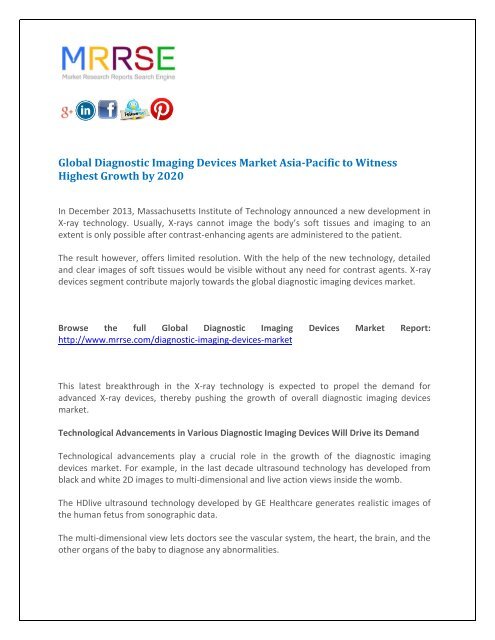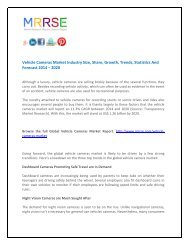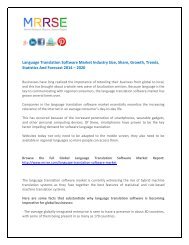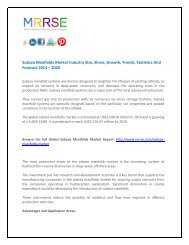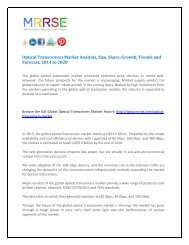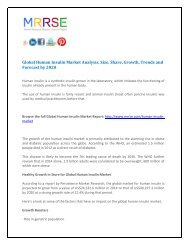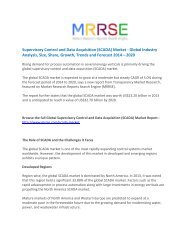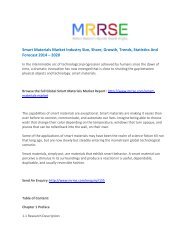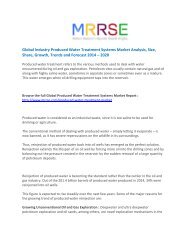o_19ofrv8jbve71b2j9liuv41p8aa.pdf
Create successful ePaper yourself
Turn your PDF publications into a flip-book with our unique Google optimized e-Paper software.
Global Diagnostic Imaging Devices Market Asia-Pacific to Witness<br />
Highest Growth by 2020<br />
In December 2013, Massachusetts Institute of Technology announced a new development in<br />
X-ray technology. Usually, X-rays cannot image the body’s soft tissues and imaging to an<br />
extent is only possible after contrast-enhancing agents are administered to the patient.<br />
The result however, offers limited resolution. With the help of the new technology, detailed<br />
and clear images of soft tissues would be visible without any need for contrast agents. X-ray<br />
devices segment contribute majorly towards the global diagnostic imaging devices market.<br />
Browse the full Global Diagnostic Imaging Devices Market Report:<br />
http://www.mrrse.com/diagnostic-imaging-devices-market<br />
This latest breakthrough in the X-ray technology is expected to propel the demand for<br />
advanced X-ray devices, thereby pushing the growth of overall diagnostic imaging devices<br />
market.<br />
Technological Advancements in Various Diagnostic Imaging Devices Will Drive its Demand<br />
Technological advancements play a crucial role in the growth of the diagnostic imaging<br />
devices market. For example, in the last decade ultrasound technology has developed from<br />
black and white 2D images to multi-dimensional and live action views inside the womb.<br />
The HDlive ultrasound technology developed by GE Healthcare generates realistic images of<br />
the human fetus from sonographic data.<br />
The multi-dimensional view lets doctors see the vascular system, the heart, the brain, and the<br />
other organs of the baby to diagnose any abnormalities.
Radiologists usually face difficulties in visualizing smaller lesions while administering smaller<br />
radiation doses. The latest PET/CT scanner offers largest axial field-of-view to help radiologists<br />
see the smaller lesions. Diagnostic imaging devices manufacturers such as Philips, Toshiba,<br />
and GE Healthcare are focusing on providing high image quality scanning with lowest possible<br />
exposure doses.<br />
MRI scanners have undergone a number of technological advancements.<br />
Request Send An Enquiry: http://www.mrrse.com/enquiry/165<br />
Chapter 1 Preface<br />
1.1 Report Description<br />
1.2 Research Methodology<br />
1.3 Assumptions<br />
Chapter 2 Market Synopsis<br />
Chapter 3 Porter’s Five Forces Analysis<br />
3.1 Bargaining Power of Suppliers<br />
3.2 Bargaining Power of Buyers<br />
3.3 Threat of New Entrants<br />
3.4 Threat of Substitutes<br />
3.5 Intensity of Rivalry
Chapter 4 Industry Overview<br />
4.1 Market Definition<br />
4.2 Market Drivers<br />
4.2.1 Growing geriatric population<br />
4.2.2 Increasing prevalence of chronic diseases and injuries<br />
4.2.3 Growing awareness about the benefits of early diagnosis of diseases among individuals<br />
4.2.4 Technological advancements and widening application of diagnostic imaging devices<br />
4.2.5 Increasing funding from government bodies<br />
4.3 Impact analysis of Market Drivers<br />
4.4 Market Restraints<br />
4.4.1 Heightened risk of cancer owing to exposure to radiation<br />
4.4.2 Shortage of helium for magnetic resonance imaging (MRI) systems<br />
4.4.3 Strict regulatory requirements<br />
4.5 Impact Analysis of Market Restraints<br />
4.6 Market Trends<br />
4.6.1 Growing product innovation<br />
4.6.2 Rising number of collaborations and partnerships<br />
Chapter 5 Global Market Size and Forecast
Chapter 6 Market Size and Forecast by X-rays<br />
6.1 X-rays<br />
6.1.1 By technology<br />
6.1.2 By portability<br />
Chapter 7 Market Size and Forecast by Ultrasound<br />
7.1 Ultrasound systems<br />
7.1.1 By technology<br />
7.1.2 By portability<br />
Chapter 8 Market Size and Forecast by Computed Tomography<br />
8.1 Computerized tomography (CT) scanner<br />
8.1.1 By type of slice<br />
Chapter 9 Market Size and Forecast by Magnetic Resonance imaging<br />
9.1 Magnetic resonance imaging (MRI)<br />
9.1.1 By architecture
Chapter 10 Market Size and Forecast by Nuclear Imaging<br />
10.1 Nuclear imaging system<br />
10.1.1 By type<br />
Chapter 11 Market Size and Forecast by Geography<br />
11.1 North America<br />
11.1.1 The U.S.<br />
11.1.2 Canada<br />
11.2 Europe<br />
11.2.1 Germany<br />
11.2.2 France<br />
11.2.3 The U.K.<br />
11.3 Asia-Pacific<br />
11.3.1 Japan<br />
11.3.2 China<br />
11.3.3 India<br />
The older MRI scanners were like a tunnel, where the patient had to lie down for about 40-60<br />
minutes to undergo complete scan. Patients suffered from claustrophobia as well as back and<br />
neck pain from lying still for a prolonged period.
The open MRI scanners have tried to solve these problems. Lately, short bore magnets have<br />
been introduced which combine the accuracy of the tunnel scanner and the comfort of an<br />
open MRI scan to provide the highest quality images. Siemens Healthcare is working on a<br />
project to develop a human brain scanner to acquire adequate knowledge to make correct<br />
diagnoses and offer treatment for various neuropsychiatric illnesses.<br />
Browse the full Press Release of Global Diagnostic Imaging Devices Market:<br />
http://www.mrrse.com/global-diagnostic-imaging-devices-market<br />
The MRI technology is constantly improving, although the end consumers (doctors and their<br />
patients) are bearing the brunt.<br />
Patient’s Comfort - a Priority while Introducing Technological Advancements<br />
With the increasing demand for better diagnostic imaging devices, the manufacturers are<br />
investing heavily in the research and development activities. Various regulations such as the<br />
Healthcare Act in the U.S. has focused more on increased speed in diagnosis and patient<br />
comfort. According to a senior manager in Toshiba, it has become important for the<br />
manufacturers to improve patient satisfaction through technological innovations.<br />
This will further pave the path for tremendous growth in the global diagnostic imaging devices<br />
market.<br />
About Us:<br />
MRRSE stands for Market Research Reports Search Engine, the largest online catalog of latest<br />
market research reports based on industries, companies, and countries. MRRSE sources<br />
thousands of industry reports, market statistics, and company profiles from trusted entities<br />
and makes them available at a click. Besides well-known private publishers, the reports<br />
featured on MRRSE typically come from national statistics agencies, investment agencies,<br />
leading media houses, trade unions, governments, and embassies.
MRRSE’s interface is tailored to provide all possible information about a market research<br />
report via a simple, snappy layout. Our refined algorithm returns specific results from<br />
hundreds of thousands of reports that lie in our database. Users can search for market<br />
research reports according to industries, sub-industries, company names or countries.<br />
Contact Us:<br />
State Tower,<br />
90 State Street,<br />
Suite 700,<br />
Albany NY - 12207<br />
United States<br />
Tel: +1-518-618-1030<br />
Email: sales@mrrse.com<br />
Website: http://www.mrrse.com/


